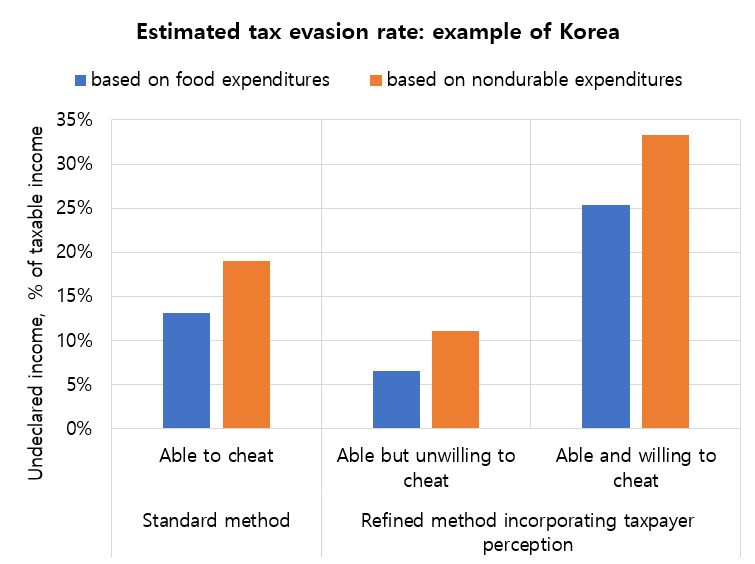Do people cheat because they can get away with it or because they feel that the rules are unfair? My recent paper examines this question in the context of tax evasion.
Unable or unwilling to cheat?
A prominent hypothesis, dating back to Becker’s ‘crime and punishment’ model, is that people cheat if the chances of getting caught and punished are low, compared to the monetary gains from cheating. In this world of information asymmetry between the taxpayer and the taxman, harder-to-detect incomes are more prone to underreporting. A prime example is business incomes of the self-employed, which are subject to neither withholding nor third-party reporting, unlike in the case of regular wages and salaries.
But there are many other aspects to tax compliance which require a better understanding of human behaviour. For instance, as emphasized in the literature on ‘tax morale’, tax decisions may also be influenced by the perception of fairness with respect to horizontal or vertical equity or to the public services one receives in exchange for the taxes paid. Overlooking those factors may result in sub-optimal policies which focus too heavily on enforcement alone.
If perception of fairness does matter, taxpayers with identical occupational or income characteristics would exhibit different compliance behaviours. Specifically, the estimated tax evasion rate would vary not only between wage earners and the self-employed but also within the self-employed. While a plausible hypothesis, empirically testing it is not so straightforward. Tax evasion is generally not readily observable and there is no reliable data. There are lab experiments with students given a hypothetical case, but some do not find them so convincing.
Looking for evidence from household surveys
An alternative approach is to look for evidence from household income and expenditure surveys. The idea is simple. Estimate the income-expenditure relationship (known as the Engel curve) for a group which is highly unlikely to cheat and for another group which is highly likely to cheat. If the elasticity of expenditures with respect to income is similar for the two groups, then the intercept difference between the two curves measures the “excess” consumption or expenditure of the latter, which is then used to estimate the undeclared fraction of taxable income.
The standard method, first applied to the UK household data and subsequently to several other countries, distinguishes taxpayers by their occupational or income type as a way of measuring their ‘ability’ to misreport income. Specifically, it compares the Engel curves of wage earners and the self-employed. But given that some people who are ‘able’ to cheat may nevertheless be ‘unwilling’ to cheat, my refined method introduces another layer of heterogeneity among taxpayers based on their perception of fairness.
Accurately measuring taxpayer perception is challenging. For instance, the World Values Survey asks whether tax evasion is ‘never, sometimes, or always justified’, but it is hard to confirm whether respondents in fact act accordingly. It is also questionable why anyone would reveal such information if there is even a small chance that it might be used against them. An alternative approach is to construct a latent variable based on taxpayer responses to questions such as: How does your tax burden compare to others’ earning similar income levels? Are the wealthy paying enough taxes? Does the quality of public services match your tax burden? This unobserved variable could be created using structural equation modelling, as explained in my paper.
An illustrative case – Korea
By way of illustration, the standard and refined methods are applied to a longitudinal household data for Korea, which has a high degree of self-employment relative to income level. The data, drawn from the National Survey on Tax and Benefits, contains information on about 5,000 households across nine years (2007-2015), and the most recent round contains question on how they perceive the tax system and the factors which affect their taxpaying decision.
The below figure shows the estimation results, based on two different measures of expenditures – the food Engel curve, as widely used in the literature, and the nondurables Engel curve, to account for demand heterogeneity among households. In case of the food Engel curve, the standard method yields a uniform tax evasion rate of 13 percent, but the refined method provides a range of 7 to 25 percent based on taxpayer perception. Estimation based on the nondurables Engel curve shows a similar trend, albeit at generally higher rates of tax evasion.
Taxpayer perception does matter
The results suggest that taxpayer perception does matter and that in some cases, monetary returns may play a relatively minor role in determining tax evasion, unlike in the case of the standard, expected utility model.
The policy implication is that, for curbing tax evasion, voluntary compliance measures and appropriate changes to the tax law may be just as necessary as enforcement measures. An optimal strategy for improving compliance may be to target both the extensive and the intensive margins: foster social and cultural norms for compliance while making cheating more difficult for those who are persistently inclined to cheat.
Source: Author, based on Daniel Jeong-Dae Lee, ‘Cheating the Government: Does Taxpayer Perception Matter?’ MPFD Working Paper 19/06. UNESCAP.
Note: The figure shows results of OLS estimator using multi-year average income to account for transitory income fluctuation which attenuates the estimate of the income elasticity and thereby overestimates tax evasion. IV estimator yields a similar trend, but with smaller variation within the self-employed. The estimated income elasticity is statistically significant and stable across difference specifications. The dummy variables – able to cheat, able but unwilling to cheat, able and willing to cheat – are all statistically significant. All control variables have the expected sign, but whereas family size, capital city dummy, age and education are statistically significant, home ownership dummy and hours worked are not. After sample restriction, there are about 24,000 observations. See paper for more details on how ‘able’ and ‘willing’ to cheat are defined.
Further reading
Lee, JD 2019, ‘Cheating the Government: Does Taxpayer Perception Matter?’ MPFD Working Paper 19/06. UNESCAP.






Thanks Daniel certainly the tax morale theorists have done a lot of work on tax evasion, with some interesting results. For me one aspect that I believe has been neglected has been the ‘values’ of taxpayers. What I mean is that some taxpayers highly value individual material wealth or standard of living than others.It’s important to understand what motivates the taxpayer and we can only find this out by identifying if material things mean more to one taxpayer than another.
A ‘keeping up with the Jones’ mentality might be stronger for those attempting to display more conspicuous consumption. In addition a copy-cat phenomenom can happen where some taxpayers might idolise a more wealthy member of society who can legally reduce his or her tax, but the tax evader is unable to do this due to the lack of high quality tax knowledge and technical expertise. The end result is that they are eventually caught by the revenue agency.
Thanks Wayne for your interesting comments. I am currently working on a paper on environmental tax reforms and one question is whether (and how much) people are willing to pay more to improve environmental quality. A related question is whether (and to what extent) what people value then gets reflected in public policy. This is in fact an issue also in corporate governance, where shareholder values other than money are currently overlooked. On your second point, I completely agree that tax avoidance by the very rich such as through offshore accounts is often within the legal boundary and yet perhaps even more harmful to society than ordinary evasion by the middle class. So closing down those ‘loopholes’ is certainly a policy priority. Fyi here is my recent research on that topic: http://www.unescap.org/publications/mpfd-working-paper-hide-and-seek-can-tax-treaties-reveal-offshore-wealth